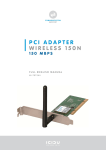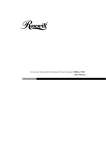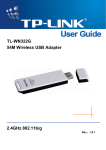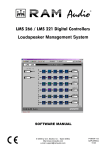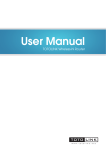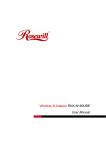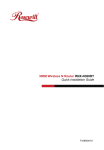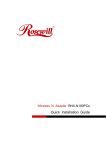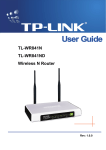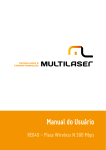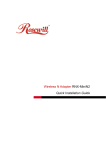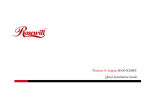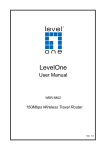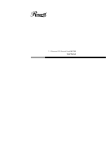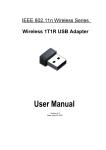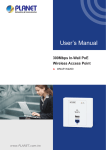Download Wireless Dual Band USB Adapter RNX
Transcript
Wireless Dual Band USB Adapter RNX-N600UB User Manual Rev: 1.0.0 1910020679 CONTENTS Package Contents .................................................................................................... 1 Chapter 1. Product Overview ................................................................................. 2 1.1 Introduction ............................................................................................................. 2 1.2 Features .................................................................................................................. 2 1.3 Hardware Overview................................................................................................. 2 Chapter 2. Installation............................................................................................. 3 2.1 Hardware Installation .............................................................................................. 3 2.2 Software Installation................................................................................................ 3 Chapter 3. Connect to a Wireless Network ........................................................... 8 3.1 Connect by ROSEWILL Wireless Utility .................................................................. 8 3.2 Connect by WPS................................................................................................... 11 3.2.1 PIN method .............................................................................................. 13 3.2.1.1 Enter the PIN from your AP device.............................................. 13 3.2.1.2 Enter a PIN into your AP device .................................................. 14 3.3 To connect using Windows built-in wireless utility................................................. 16 3.3.1. In Windows XP ......................................................................................... 16 3.3.2. In Windows Vista...................................................................................... 18 3.3.3. In Windows 7............................................................................................ 20 3.3.4. Windows 8................................................................................................ 21 Chapter 4. Management ........................................................................................ 24 4.1 Profile.................................................................................................................... 24 4.1.1 Add a profile ............................................................................................. 24 4.1.1.1 Add a profile in Infrastructure mode ............................................ 24 4.1.1.2 Add a profile in ad hoc mode....................................................... 26 4.1.2 Modify a profile ......................................................................................... 28 4.1.3 Delete a profile ......................................................................................... 29 4.2 Advanced .............................................................................................................. 29 4.3 About..................................................................................................................... 30 Chapter 5. AP Mode .............................................................................................. 31 Chapter 6. Uninstall Software............................................................................... 33 6.1 In Windows XP/Vista/7.......................................................................................... 33 6.1.1 Uninstall the utility software from your PC................................................ 33 6.1.2 Uninstall the driver software from your PC ............................................... 35 6.2 In Windows 8......................................................................................................... 37 6.2.1 Uninstall the utility software from your PC................................................ 37 6.2.2 Uninstall the driver software from your PC ............................................... 38 Appendix A: Specifications................................................................................... 41 Appendix B: Glossary............................................................................................ 42 Appendix C: Certification and Regulation ........................................................... 44 Wireless Dual Band USB Adapter RNX-N600UB User Manual Package Contents Please verify that all the package contents below are available. 1 * RNX-N600UB Wireless Dual Band USB Adapter 1 * Quick Installation Guide 1 * USB cable One Resource CD for RNX-N600UB, including: Rosewill Wireless Configuration Utility and Drivers User Manual Other helpful information Make sure that the above items are contained in the package. If any of the above items are damaged or missing, please contact your distributor. Note: The ‘adapter’ mentioned in this User Guide stands for RNX-N600UB Wireless Dual Band USB Adapter without any explanations. 1 Wireless Dual Band USB Adapter RNX-N600UB User Manual Chapter 1. Product Overview 1.1 Introduction The adapter is an 802.11n client device designed to deliver a high-speed and unrivaled wireless performance for your devices. It has better speed and range with less interference compared to other 11N adapters, thus you can get a better Internet experience, such as downloading, online gaming, Internet phone calls and video streaming. With 802.11n technology, higher throughput improvement by 2T2R, the RNX-N600UB’s auto-sensing capability allows high packet transfer rate of up to 300Mbps for maximum throughput. It has good capability on anti-jamming, and it can also interoperate with 802.11b products. The adapter supports WEP, WPA and WPA2 encryption to protect and secure your personal information. The adapter is easy to install and manage with the Quick Setup Wizard guiding you step-by-step through the installation process and the ROSEWILL Wireless Configuration Utility leads you to set up a wireless connection fast. With excellent wireless performance, reception, and security protection, the RNX-N600UB is the best choice for easily adding or upgrading wireless connectivity to your devices. 1.2 Features Complies with IEEE802.11n/g/b/a standards Supports WPA-PSK/WPA2-PSK, WPA/WPA2, TKIP/AES encryption, WEP encryption 300Mbps maximum throughput for 2.4 and 5.0 GHz Supports Ad-Hoc and Infrastructure modes Supports roaming between access points when configured in Infrastructure mode Supports Windows 8, Windows 7, Windows Vista, and Windows XP 1.3 Hardware Overview LED status: Status On Working Status The adapter has connected to a network. Flashing Slowly The driver has been installed but no data is being transmitted or received. Flashing Quickly Data is being transmitted or received. Note: When the adapter failed to connect to a wireless network, the LED may be off. Please choose your network and try to connect again. 2 Wireless Dual Band USB Adapter RNX-N600UB User Manual Chapter 2. Installation 2.1 Hardware Installation There are two methods: (1) Plug the adapter into an available USB interface on your computer directly. (2) Connect the adapter and your computer with the provided USB cable. Note: When the Found New Hardware wizard appears, click Cancel. 2.2 Software Installation The adapter’s Setup Wizard will guide you through the installation procedures for Windows 8, Windows 7, Windows Vista, and Windows XP. The procedures in different systems are quite similar; therefore here we use the procedures in Windows 7 as an example. Insert the Resource CD into your CD-ROM drive, and open the folder named RNX-N600UB. Double-click Setup.exe in the proper folder to start the installation. 1. The InstallShield Wizard window will appear. Click Next to continue. 3 Wireless Dual Band USB Adapter RNX-N600UB 2. User Manual Figure 2-1 Choose a setup type. It is recommended to select Install Rosewill Wireless Configuration Utility and Driver. Selecting Install Driver Only will only install driver and you will not be able to manage the networks through ROSEWILL configuration utility. Click Next to continue. Figure 2-2 3. Click Change to specify the destination location for the software or you can leave it default. Click Next in the screen below to continue. 4 Wireless Dual Band USB Adapter RNX-N600UB Figure 2-3 4. Click Install to continue the setup. Figure 2-4 5. The utility and drivers will install. This may take 1~2 minutes. 5 User Manual Wireless Dual Band USB Adapter RNX-N600UB Figure 2-5 6 User Manual Wireless Dual Band USB Adapter RNX-N600UB 6. User Manual After all the steps above, you will see the screen below. Click Finish to complete the setup. Figure 2-6 7. After installation, the utility configuration page will automatically pop up as shown in the following figure and the icon will appear on your desktop. To connect to a network, please refer to Chapter 3 Connect to a Wireless Network. Figure 2-7 Note: If you have only installed the driver, the above configuration page will not pop up. You need to use the Windows built-in wireless utility to connect to and manage your network. 7 Wireless Dual Band USB Adapter RNX-N600UB User Manual Chapter 3. Connect to a Wireless Network With both the hardware and software successfully installed into your computer, you can quickly connect to a wireless network using one of the following methods. 1. To connect using ROSEWILL Wireless Configuration Utility RNX-N600UB uses the ROSEWILL Wireless Configuration Utility as the management software. The utility provides you an easy interface to connect to a network and to change any settings related to the wireless adapter. 2. To connect using WPS Just by pushing the WPS button, you can set up a wireless connection quickly under the condition that your router or access point supports WPS (also called QSS). 3. To connect using Windows built-in wireless utility Windows users may use the built-in wireless utility to connect to a wireless network. For specific operations, please go to 3.3 To connect using Windows built-in wireless utility. 3.1 Connect by ROSEWILL Wireless Utility 1. After installation, the utility configuration page will automatically pop up on the screen. If the utility page does not pop up, you can launch the utility by double-clicking the desktop. Figure 3-1 8 icon on your Wireless Dual Band USB Adapter RNX-N600UB 2. User Manual The Network page will display all wireless networks that are available in your area. To connect to a network, simply select the wireless network name and click Connect. SSID (Service Set Identifier) is the name of the wireless network. The adapter will automatically connect to your target network next time and automatically save it as a profile if you choose Connect automatically. Figure 3-2 3. If word None appears behind the SSID, this means the network to be connected is not security-enabled and you can connect to the network without entering a key. To prevent outside intrusion and safeguard your network, it is strongly recommended that you set a password to your router or access point. Figure 3-3 9 Wireless Dual Band USB Adapter RNX-N600UB User Manual If there is a “lock” icon behind the SSID, this means the wireless network is secured and the corresponding security type will display. You must know the encryption key/security settings to connect, and key in the password which can be found on the configuration page of your router or access point, then click OK to continue. Or push the WPS / QSS button on your router if your router features the WPS / QSS function to quickly build a connection without having to enter a key. Figure 3-4 4. You have successfully connected to your network and can enjoy the Internet service now. Click Close to enjoy the Internet. Figure 3-5 10 Wireless Dual Band USB Adapter RNX-N600UB 5. User Manual To view more information about the network currently connected, click Status in the tools section and the page will display information such as the network type, link quality and wireless mode. Figure 3-6 3.2 Connect by WPS WPS (Wi-Fi Protected Setup) function allows you to add a new wireless device to an existing network quickly. 1. If the wireless router supports WPS (or QSS), you can establish a wireless connection between the wireless card and router using either Push Button Configuration (PBC) method or PIN method. Three WPS connection methods are listed in the following parts. PBC (Push Button Configuration) method 2. Press the WPS button on the back panel of the router. Here takes Router RNX-N150RT for example; press the WPS/Reset button for 2~3 seconds. Figure 3-7 3. Press the WPS button on the adapter. There are two ways: Press and hold the WPS button on the adapter directly for 2~3 seconds until Figure 3-9 appears. 11 Wireless Dual Band USB Adapter RNX-N600UB User Manual Figure 3-8 Figure 3-9 1) Open the utility and click WPS tab. Select Push the button on my access point or wireless router and then click Connect. Figure 3-10 4. When the following window appears, you have successfully connected to the network. Click OK to finish the WPS connection. 12 Wireless Dual Band USB Adapter RNX-N600UB User Manual Figure 3-11 3.2.1 PIN method There are two ways to configure the WPS by PIN method: 1) Enter the PIN from your AP device. 2) Enter a PIN into your AP device. Following are detailed configuration procedures of each way. 3.2.1.1 Enter the PIN from your AP device 1. Open the utility and click WPS tab. Select Enter the PIN of my access point or wireless router. In the empty field beside PIN, enter the PIN labeled on the bottom of the router (here we use 13492564 as an example). If you have generated a new PIN code for your router, please enter the new one instead. Click Connect to continue. Figure 3-12 13 Wireless Dual Band USB Adapter RNX-N600UB 2. User Manual The adapter will be connecting to the target network. Figure 3-13 3. When Figure 3-11 appears, you have successfully connected to the network. 3.2.1.2 Enter a PIN into your AP device 1. Open the utility and click WPS tab. Select Enter the PIN of this device into my access point or wireless router. In the field beside PIN, you will see the PIN value of the adapter which is randomly generated. Click Connect to continue. Figure 3-14 2. Open your router’s Web-based Utility and click WPS link on the left of the main menu. Then click “Add device” and the following figure will appear. Enter the PIN value of the adapter in the empty field beside PIN and then click Connect. 14 Wireless Dual Band USB Adapter RNX-N600UB User Manual Figure 3-15 3. When Connect successfully appears on the screen, the WPS configuration is complete. Or you can view the adapter’s utility page to see whether the connection has been successful as shown in Figure 3-16. Figure 3-16 15 Wireless Dual Band USB Adapter RNX-N600UB 3.3 3.3.1. User Manual To connect using Windows built-in wireless utility In Windows XP Windows XP users may use the built-in wireless utility. Follow the steps below. 1 Right-click on the utility icon in your system tray (lower-right corner). Select Switch to Windows Wireless Configuration tool. Figure 3-17 Or double-click the utility icon to load the utility configuration page. Click Advanced in the tools section and then select Use Windows wireless configuration tool in the figure shown below. Click OK when Figure 3-19 appears to continue. Figure 3-18 16 Wireless Dual Band USB Adapter RNX-N600UB 2 User Manual Figure 3-19 Right-click on the wireless computer icon in your system tray (lower-right corner). Select View Available Wireless Networks. Figure 3-20 3 The utility will display any available wireless networks in your area. Click on a network (displayed using the SSID) and click the Connect button. Figure 3-21 4 If the network is security-enabled, you will be prompted to enter the key as shown below. If not, you will connect to the network directly without entering a key. 17 Wireless Dual Band USB Adapter RNX-N600UB User Manual Figure 3-22 3.3.2. In Windows Vista Windows Vista users may use the built-in wireless utility. Follow the steps below. Open the wireless utility by right-clicking on the wireless computer icon in your system tray as shown in the figure below. Select Connect to a network. Figure 3-23 The utility will display any available wireless networks in your area. Select the wireless network you would like to connect and then click Connect. Figure 3-24 18 Wireless Dual Band USB Adapter RNX-N600UB User Manual If the network you would like to connect is security-enabled, enter the same security key or passphrase that is on your router. If the network to be connected is not secure, the connection will be built without entering a key. Figure 3-25 You have successfully connected to the network now and can surf the Internet now. Figure 3-26 19 Wireless Dual Band USB Adapter RNX-N600UB 3.3.3. User Manual In Windows 7 Windows 7 users may use the built-in wireless utility. Follow the steps below. 1. Left-click the wireless icon in your system tray (lower-right corner) as shown in the figure below. The utility will display any available wireless networks in your area. Select the wireless network (displayed using the SSID) to be connected and then click Connect. Figure 3-27 2. If the network you would like to connect is security-enabled, enter the same security key or passphrase that is on your router. Or push the WPS button (also called QSS) on the router or access point (You will be prompted to push the button on the window if WPS function is supported as shown in the figure below). If the network to be connected is not secure, the connection will be built without entering a key. 20 Wireless Dual Band USB Adapter RNX-N600UB User Manual Figure 3-28 3. You have successfully connected to the network and can use the Internet now. Figure 3-29 3.3.4. Windows 8 Windows 8 users may use the built-in wireless utility. Follow the steps below. 1. Click the icon at the bottom of your screen, and a network list will appear at the right side of your screen. Select your target network, and then click Connect. 21 Wireless Dual Band USB Adapter RNX-N600UB 2. User Manual Figure 3-30 If the network is unencrypted, you will directly connect to it. If the network is encrypted, enter the password (network security key) and then click Next to continue. Figure 3-31 Note: You can also push the WPS/ QSS button on your router as hinted “You can also connect by pushing the button on the router”. Then click Next to continue. 3. When Connected appears behind the SSID (as shown below), you have successfully connected to the target network. Figure 3-32 Note: If the adapter is connected to the network for the first time, you will be asked whether to turn on sharing or connect to devices. Please select “Yes, ...”or “No, ...” according to your Internet environment. 22 Wireless Dual Band USB Adapter RNX-N600UB Figure 3-33 23 User Manual Wireless Dual Band USB Adapter RNX-N600UB User Manual Chapter 4. Management This section will show you how to configure your RNX-N600UB adapter using the ROSEWILL Wireless Configuration Utility.The RNX-N600UB adapter uses the ROSEWILL Wireless Configuration Utility as the management software. The utility provides users with an easy interface to change any settings related to the adapter. Double-clicking on the icon on your desktop will start the utility. 4.1 Profile Your wireless networks may vary in different places like home, office or coffee shop. With Profile management, you can easily save and manage various networks to be connected, saving you the trouble of having to repeat the same configurations. Click Profile in the tools section, the following page will appear. Figure 4-1 4.1.1 Add a profile To add a profile, click the Add button on the bottom of the screen. Then the configuration window will appear. 4.1.1.1 Add a profile in Infrastructure mode If you are connecting to a wireless router or access point, select Infrastructure as the Network Type in the screen that appears and follow the instructions below to finish the setting. 24 Wireless Dual Band USB Adapter RNX-N600UB User Manual Figure 4-2 The following items can be found on the screen. Profile Name: Enter a name for your profile e.g. Home, Office, Coffee Shop. The same name is not allowed. Please also note that no space is allowed between words. SSID: Select the target network from the drop-down list. Network Type: Select the network type. If you are connecting to a wireless router or access point, select Infrastructure. If you are connecting to another wireless client such as an adapter, select ad hoc. Security Type: Select the security type from the list. Four options are available: WPA-PSK/WPA2-PSK, WPA/WPA2, WEP and None. The security type should be the same as on your router or access point, otherwise, you will not be able to build a successful connection. WPA-PSK/WPA2-PSK uses a passphrase or key to authenticate your wireless connection. The key must be the exact same key entered on your wireless router or access point. None stands for no security. It is recommended to enable WPA-PSK/WPA2-PSK on your wireless router or access point before configuring your wireless adapter. Encryption Type: From the drop-down menu, select the encryption type that is the same as on your router or access point. Security Key: Enter the passphrase exactly as it is on your wireless router or access point. Click the Show characters box to see the passphrase. Unchecking it will hide it. Start this connection automatically: Check this box to automatically connect to this network next time. Save: Click Save to save your settings. 25 Wireless Dual Band USB Adapter RNX-N600UB User Manual Complete the above settings, the Profile page should looks like the following figure. To connect to a desired network, just highlight the network you would like to connect to and click the Connect button on the bottom of the window Figure 4-3 4.1.1.2 Add a profile in ad hoc mode If you are connecting to another wireless client such as an adapter, select ad hoc as the Network Type in the screen that appears and follow the instructions below to finish the setting. This function doesn’t support in Windows 8. Figure 4-4 The following items can be found on the screen. 26 Wireless Dual Band USB Adapter RNX-N600UB User Manual Profile Name: Enter a name for your profile e.g. Home, Office, Coffee Shop. The same name is not allowed. Please also note that no space is allowed between words. SSID: Select the target network from the drop-down list. Network Type: Select the network type. If you are connecting to a wireless router or access point, select Infrastructure. If you are connecting to another wireless client such as an adapter, select ad hoc. Band: This item determines which operating frequency will be used. Two options are available: 2.4Ghz and 5Ghz. It is recommended that your computers and devices running video and voice applications use the 5Ghz band, while your guest access and computers that are only browsing the web use the 2.4Ghz band. 2.4 Ghz - You can use the 2.4GHz band to connect to many classic wireless devices like gaming consoles, laptops, DVRs, etc. 5.0 Ghz - This band is less crowded and is used for time-sensitive music, video streaming or gaming. Using this band can avoid interference with 2.4GHz networks or noisy devices like cordless phones and microwave ovens. Security Type: Select the security type from the list. Two options are available: WEP and None. None stands for no security. It is recommended that you select WEP to secure your wireless network. Encryption Type: If you select None as the Security Type, the Encryption Type will be None accordingly. If you select WEP as the Security Type, the Encryption Type will be Open. Key Index: You can select ASCII or Hexadecimal format on the right. ASCII format stands for any combination of keyboard characters in the specified length. Hexadecimal format stands for any combination of hexadecimal digits (0-9, a-f, A-F) in the specified length. For 64-bit encryption - You can enter 10 hexadecimal digits (any combination of 0-9, a-f, A-F, zero key is not permitted) or 5 ASCII characters. For 128-bit encryption - You can enter 26 hexadecimal digits (any combination of 0-9, a-f, A-F, zero key is not permitted) or 13 ASCII characters. Security Key: Enter the passphrase. Click the Show characters box to see the passphrase. Unchecking it will hide it. Start this connection automatically: Check this box to automatically connect to this network next time. Save: Click Save to save your settings. 27 Wireless Dual Band USB Adapter RNX-N600UB User Manual Complete the above settings, the Profile page should looks like the following figure. To connect to a desired network, just highlight the network you would like to connect to and click the Connect button on the bottom of the window. Figure 4-5 4.1.2 Modify a profile You may edit an existing profile by clicking the Modify button from the Profile page. For instance, you may like to change the profile name from Home to Home1 or you may want to specify another SSID for profile Home. After all the changes, click Save to make the changes take effect. Figure 4-6 28 Wireless Dual Band USB Adapter RNX-N600UB User Manual 4.1.3 Delete a profile To delete an existing profile, highlight the profile name and click Remove on the bottom of the screen or press the Delete button on your keyboard. When the following figure appears, click OK to continue. Figure 4-7 4.2 Advanced The following configurations can be made on the Advanced page: 1) To select wireless configuration tool. Here you can decide which tool to use, either the ROSEWILL Configuration Utility or the Windows wireless configuration tool. This option is available only in Windows XP. 2) To switch to another wireless network adapter. Here you can switch to another adapter installed in your computer. The adapters successfully installed in your computer will be listed in the drop-down menu if the adapters are supported by this utility. 3) To switch to SoftAP mode. Once enabled, the adapter will be able to work as an AP. 4) To change the power save mode. The default option is OFF. 29 Wireless Dual Band USB Adapter RNX-N600UB User Manual Figure 4-8 4.3 About The About screen gives you information about the Driver and Utility versions of the adapter. Right-click on the icon in your system tray and select About from the list. The actual UI/WFF/Driver version may differ from that in the figure below. Please refer to the actual interface of the product. Figure 4-9 30 Wireless Dual Band USB Adapter RNX-N600UB User Manual Chapter 5. AP Mode In Soft AP mode, the adapter will work as an AP. Suppose that only one computer in your house can access the Internet for various reasons like only one WLAN port is available on your wired broadband router, however, other wireless-capable devices also want to share the Internet. Then the adapter can be configured as an AP under the Soft AP mode, saving you the trouble of having to get a separate access point or a router. With this feature, a computer can use a single physical wireless adapter to connect as a client to a hardware access point while at the same time acting as a software AP allowing other wireless-capable devices to connect to it. To switch to this mode, right-click on the utility icon in your system tray and select Switch to SoftAP mode. Figure 5-1 Or from the Advanced page of the utility, tick ON under the SoftAP mode as shown in the following figure. Click OK when prompted to confirm the setting. Figure 5-2 31 Wireless Dual Band USB Adapter RNX-N600UB User Manual The Soft AP icon should then appear beside Advanced icon in the utility. Figure 5-3 Figure 5-4 SoftAP mode: Select to enable or disable the function. Internet Connecting Share (ICS): Specify a connection through which devices connected to your AP can access the Internet. SSID: Enter the name for your soft AP (for example, Jone) so that others can know which AP is yours when trying to connect to it. Security Type: The security type here is set to be WPA2-PSK which is based on 802.11i and uses AES (Advanced Encryption Standard) instead of TKIP. It was designed to improve the security features of WEP. WPA2-PSK uses a passphrase or key to authenticate your wireless connection. You needn’t make any configuration here. Encryption Type: The encryption type here is set to be AES. Security Code: Enter the Code in the field to make your AP security enabled. It is recommended that you key in another instead of the default: 12345678. Only entering the corresponding key can establish a successful connection between your AP other PCs. IP Address: Here displays the IP address of the SoftAP. Having completed the above settings, click Apply; then Figure 5-4 will pop up, where you click OK to make Soft AP mode take effect. 32 Wireless Dual Band USB Adapter RNX-N600UB User Manual Chapter 6. Uninstall Software 6.1 In Windows XP/Vista/7 The software uninstall steps are similar in Windows XP, Windows Vista, and Windows 7, here we just take Windows 7 for example. 6.1.1 Uninstall the utility software from your PC 1. On the Windows taskbar, click the Start button, click All programs Rosewill, and then click Uninstall- Rosewill Wireless Configuration Utility. Figure 6-1 33 Wireless Dual Band USB Adapter RNX-N600UB 2. The following screen will appear. Figure 6-2 3. Click Yes. Figure 6-3 4. Click Finish. 34 User Manual Wireless Dual Band USB Adapter RNX-N600UB User Manual Figure 6-4 6.1.2 Uninstall the driver software from your PC 1. On the Windows taskbar, click the Start button, and then click All programs Rosewill. 35 Wireless Dual Band USB Adapter RNX-N600UB User Manual Figure 6-5 Device Manager 2. Click Uninstall –Rosewill RNX-N600UB Driver shown in above figure, the system will uninstall the driver software of the adapter from your PC. 36 Wireless Dual Band USB Adapter RNX-N600UB 6.2 User Manual In Windows 8 6.2.1 Uninstall the utility software from your PC 1. Enter the Metro interface,right-click any blank place in the Metro interface, then App Bar will appear below the Metro interface, click All apps. Find the ROSEWILL application, and click Uninstall- Rosewill Wireless Configuration Utility. Figure 6-6 2. Click Yes to start uninstalling the utility software from your PC. Figure 6-7 3. It may take a few minutes to undergo the whole un-installation process. 37 Wireless Dual Band USB Adapter RNX-N600UB User Manual Figure 6-8 4. Click Finish when the figure below appears. Figure 6-9 6.2.2 Uninstall the driver software from your PC 1. Enter the Metro interface,right-click any blank place in the Metro interface, then App Bar will appear below the Metro interface, click All apps. Find the ROSEWILL application, and click Uninstall –Rosewill RNX-N600UB Driver. 38 Wireless Dual Band USB Adapter RNX-N600UB Figure 6-10 2. Click Yes to start uninstalling the driver software from your PC. Figure 6-11 3. It may take a few minutes to undergo the whole un-installation process. Figure 6-12 4. Click Finish when the figure below appears. 39 User Manual Wireless Dual Band USB Adapter RNX-N600UB Figure 6-13 40 User Manual Wireless Dual Band USB Adapter RNX-N600UB User Manual Appendix A: Specifications Normal Interface USB 2.0 Interface Standards IEEE802.11a, IEEE 802.11b, IEEE 802.11n, IEEE 802.11g Operating System Windows 8, Windows 7, Windows Vista, Windows XP Throughput 300Mbps (Maximal) 11a: 6/9/12/18/24/36/48/54Mbps Radio Data Rate 11b: 1/2/5.5/11Mbps 11g: 6/9/12/18/24/36/48/54Mbps 11n: Up to 300Mbps 11a:OFDM Modulation 11b:CCK,QPSK,BPSK 11g:OFDM 11n: QPSK,BPSK,16-QAM,64-QAM Media Access Protocol CSMA/CA with ACK Data Security WPA-PSK/WPA2-PSK, WPA/WPA2, WEP, TKIP/AES Frequency* 2.4~2.4835GHz,5.15~5.35GHz,5.745~5.825GHz Spread Spectrum Direct Sequence Spread Spectrum (DSSS) Safety & Emissions FCC, CE Environmental and Physical Working Temperature 0℃~40℃ (32℉~104℉) Working Humidity 10% ~ 90% RH, Non-condensing Storage Temperature -40℃~70℃(-40℉~158℉) Storage Humidity 5% ~ 90% RH, Non-condensing * 1. Only 2.412GHz~2.462GHz is allowed to be used in USA, which means only channel 1~11 is available for American users to choose. 2. Rules on the use of 5GHz band channels may vary according to different national laws. 41 Wireless Dual Band USB Adapter RNX-N600UB User Manual Appendix B: Glossary 802.11a - Specification for wireless networking at 54 Mbps using OFDM modulation and operating in radio band at 5GHz. 802.11b - The 802.11b standard specifies a wireless product networking at 11 Mbps using direct-sequence spread-spectrum (DSSS) technology and operating in the unlicensed radio spectrum at 2.4GHz, and WEP encryption for security. 802.11b networks are also referred to as Wi-Fi networks. 802.11g - specification for wireless networking at 54 Mbps using direct-sequence spread-spectrum (DSSS) technology, using OFDM modulation and operating in the unlicensed radio spectrum at 2.4GHz, and backward compatibility with IEEE 802.11b devices, and WEP encryption for security. 802.11n - 802.11n builds upon previous 802.11 standards by adding MIMO (multiple-input multiple-output). MIMO uses multiple transmitter and receiver antennas to allow for increased data throughput via spatial multiplexing and increased range by exploiting the spatial diversity, perhaps through coding schemes like Alamouti coding. The Enhanced Wireless Consortium (EWC) was formed to help accelerate the IEEE 802.11n development process and promote a technology specification for interoperability of next-generation wireless local area networking (WLAN) products. Ad hoc Network - An ad hoc network is a group of computers, each with a Wireless Adapter, connected as an independent 802.11 wireless LAN. Ad hoc wireless computers operate on a peer-to-peer basis, communicating directly with each other without the use of an access point. Ad hoc mode is also referred to as an Independent Basic Service Set (IBSS) or as peer-to-peer mode, and is useful at a departmental scale or SOHO operation. DSSS - (Direct-Sequence Spread Spectrum) - DSSS generates a redundant bit pattern for all data transmitted. This bit pattern is called a chip (or chipping code). Even if one or more bits in the chip are damaged during transmission, statistical techniques embedded in the receiver can recover the original data without the need of retransmission. To an unintended receiver, DSSS appears as low power wideband noise and is rejected (ignored) by most narrowband receivers. However, to an intended receiver (i.e. another wireless LAN endpoint), the DSSS signal is recognized as the only valid signal, and interference is inherently rejected (ignored). FHSS - (Frequency Hopping Spread Spectrum) - FHSS continuously changes (hops) the carrier frequency of a conventional carrier several times per second according to a pseudo-random set of channels. Because a fixed frequency is not used, and only the transmitter and receiver know the hop patterns, interception of FHSS is extremely difficult. Infrastructure Network - An infrastructure network is a group of computers or other devices, each with a Wireless Adapter, connected as an 802.11 wireless LAN. In infrastructure mode, the wireless devices communicate with each other and to a wired network by first going through an access point. An infrastructure wireless network connected to a wired network is referred to as a Basic Service Set (BSS). A set of two or more BSS in a single network is referred to as an 42 Wireless Dual Band USB Adapter RNX-N600UB User Manual Extended Service Set (ESS). Infrastructure mode is useful at a corporation scale, or when it is necessary to connect the wired and wireless networks. Spread Spectrum - Spread Spectrum technology is a wideband radio frequency technique developed by the military for use in reliable, secure, mission-critical communications systems. It is designed to trade off bandwidth efficiency for reliability, integrity, and security. In other words, more bandwidth is consumed than in the case of narrowband transmission, but the trade off produces a signal that is, in effect, louder and thus easier to detect, provided that the receiver knows the parameters of the spread-spectrum signal being broadcast. If a receiver is not tuned to the right frequency, a spread-spectrum signal looks like background noise. There are two main alternatives, Direct Sequence Spread Spectrum (DSSS) and Frequency Hopping Spread Spectrum (FHSS). SSID - A Service Set Identification is a thirty-two character (maximum) alphanumeric key identifying a wireless local area network. For the wireless devices in a network to communicate with each other, all devices must be configured with the same SSID. This is typically the configuration parameter for a wireless PC card. It corresponds to the ESSID in the wireless Access Point and to the wireless network name. See also Wireless Network Name and ESSID. WEP - (Wired Equivalent Privacy) - A data privacy mechanism based on a 64-bit or 128-bit or 152-bit shared key algorithm, as described in the IEEE 802.11 standard. To gain access to a WEP network, you must know the key. The key is a string of characters that you create. When using WEP, you must determine the level of encryption. The type of encryption determines the key length. 128-bit encryption requires a longer key than 64-bit encryption. Keys are defined by entering in a string in HEX (hexadecimal - using characters 0-9, A-F) or ASCII (American Standard Code for Information Interchange – alphanumeric characters) format. ASCII format is provided so you can enter a string that is easier to remember. The ASCII string is converted to HEX for use over the network. Four keys can be defined so that you can change keys easily. Wi-Fi - A trade name for the 802.11b wireless networking standard, given by the Wireless Ethernet Compatibility Alliance (WECA, see http://www.wi-fi.net), an industry standards group promoting interoperability among 802.11b devices. WLAN - (Wireless Local Area Network) - A group of computers and associated devices communicate with each other wirelessly, which network serving users are limited in a local area. WPA - (Wi-Fi Protected Access) - A wireless security protocol uses TKIP (Temporal Key Integrity Protocol) encryption, which can be used in conjunction with a RADIUS server. 43 Wireless Dual Band USB Adapter RNX-N600UB User Manual Appendix C: Certification and Regulation COPYRIGHT & TRADEMARKS Specifications are subject to change without notice. is a registered trademark of Rosewill.Limited. Other brands and product names are trademarks or registered trademarks of their respective holders. No part of the specifications may be reproduced in any form or by any means or used to make any derivative such as translation, transformation, or adaptation without permission from Rosewill.Limited Copyright © 2014. All rights reserved. http://www.rosewill.com FCC STATEMENT This equipment has been tested and found to comply with the limits for a Class B digital device, pursuant to part 15 of the FCC Rules. These limits are designed to provide reasonable protection against harmful interference in a residential installation. This equipment generates, uses and can radiate radio frequency energy and, if not installed and used in accordance with the instructions, may cause harmful interference to radio communications. However, there is no guarantee that interference won’t occur in a particular installation. If this equipment does cause harmful interference to radio or television reception, which can be determined by turning the equipment off and on, the user is encouraged to try to correct the interference by one or more of the following measures: Reorient or relocate the receiving antenna. Increase the separation between the equipment and receiver. Connect the equipment into an outlet on a circuit different from that to which the receiver is connected. Consult the dealer or an experienced radio/ TV technician for help. This device complies with part 15 of FCC Rules. Operation is subject to the following two conditions: 1) This device may not cause harmful interference. 2) This device must accept any interference received, including interference that may cause undesired operation. Any changes or modifications not expressly approved by the party responsible for compliance could void the user’s authority to operate the equipment. Note: The manufacturer isn’t responsible for any radio or tv interference caused by unauthorized modifications to this equipment. Such modifications could void the user’s authority to operate the equipment. FCC RF Radiation Exposure Statement: This equipment complies with FCC radiation exposure limits set forth for an uncontrolled environment. End users must follow the specific operating instructions for satisfying RF exposure 44 Wireless Dual Band USB Adapter RNX-N600UB User Manual compliance. This transmitter must not be co-located or operating in conjunction with any other antenna or transmitter. This equipment has been SAR-evaluated for use in hand. SAR measurements are based on 5mm spacing from the body and that compliance is achieved at that distance. CE Mark Warning This is a class B product. In a domestic environment, this product may cause radio interference, in which case the user may be required to take adequate measures. National Restrictions This device is intended for home and office use in all EU countries (and other countries following the EU directive 1999/5/EC) without any limitation except for the countries mentioned below: Country Restriction Bulgaria None France Reason/remark General authorization required for outdoor use and public service Outdoor use limited Military Radiolocation use. Refarming of the 2.4 to 10 mW e.i.r.p. GHz band has been ongoing in recent years to within allow the band 2454-2483.5 MHz Italy None Luxembourg None Implemented relaxed If used outside of own None Full premises, general authorization is required General authorization required for network and service supply(not for spectrum) subsection does not apply for the geographical area within a radius of 20 km from the centre of Ny-Ålesund Russian regulation. implementation planned 2012 This Norway current Only for indoor applications Federation Note: Please don’t use the product outdoors in France. 45 Wireless Dual Band USB Adapter RNX-N600UB User Manual This device has been designed to operate with the antennas listed below which have a maximum gain of 3 dBi. Antennas not included in this list or having a gain greater than 3 dBi are strictly prohibited for use with this device. The required antenna impedance is 50 ohms. To reduce potential radio interference to other users, the antenna type and its gain should be so chosen that the equivalent isotropically radiated power (e.i.r.p.) is not more than that permitted for successful communication. 46 Wireless Dual Band USB Adapter RNX-N600UB User Manual Canadian Compliance Statement This device complies with Industry Canada license-exempt RSS standard(s). Operation is subject to the following two conditions: (1) This device may not cause interference, and (2)This device must accept any interference, including interference that may cause undesired operation of the device. Cet appareil est conforme aux norms CNR exemptes de licence d’Industrie Canada. Le fonctionnement est soumis aux deux conditions suivantes: (1) cet appareil ne doit pas provoquer d’interférences et (2) cet appareil doit accepter toute interférence, y compris celles susceptibles de provoquer un fonctionnement non souhaité de l’appareil. Industry Canada Statement: Complied with the Canadian ICES-003 Class B specifications Cet appareil numérique de la classe B est conforme à la norme NMB-003 du Canada. This device complies with RSS 210 of Industry Canada. This Class B device meets all the requirements of the Canadian interference-causing equipment regulations. Cet appareil numérique de la Classe B respecte toutes les exigences du Règlement sur le matériel brouilleur du Canada. Safety Information When product has power button, the power button is one of the way to shut off the product; when there is no power button, the only way to completely shut off power is to disconnect the product or the power adapter from the power source. Don’t disassemble the product, or make repairs yourself. You run the risk of electric shock and voiding the limited warranty. If you need service, please contact us. Avoid water and wet locations. This product can be used in the following countries: AT BG BY CA CZ DE DK EE ES FI FR GB GR HU IE IT LT LV MT NL NO PL PT RO RU SE SK TR UA 47



















































